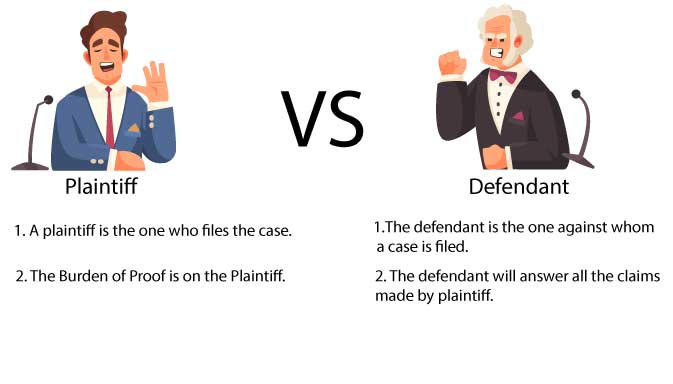Have you ever watched a courtroom scene in a movie and wondered who exactly the defendant and plaintiff are? Maybe you’ve heard these terms during a legal drama or even while reading about a real-life case. At first glance, they might sound like complicated legal jargon, but the truth is, they’re not as confusing as they seem. Understanding who the defendant and plaintiff are can help you make sense of how legal cases work in real life.
So, let’s break it all down in a simple, friendly way — without the heavy legal talk. By the end of this article, you’ll not only know the difference between a defendant and a plaintiff, but you’ll also understand how their roles shape every lawsuit or legal battle.
Understanding the Basics: Who Is the Plaintiff?
The plaintiff is the person or party who starts a lawsuit. Think of them as the one who brings a complaint to court. In other words, they’re saying, “Something wrong happened, and I want justice.”
In a civil case, the plaintiff usually claims that the defendant — the other party — did something wrong that caused harm, damage, or loss. The plaintiff’s goal is to convince the court that their complaint is valid and that the defendant should be held responsible.
For example, imagine that you hired a contractor to remodel your kitchen, but they left the work incomplete after taking your payment. If you decide to sue them, you become the plaintiff in the case. You’re the one filing the lawsuit, asking the court to make things right.
Who Is the Defendant?
Now let’s talk about the defendant — the person or entity being accused. In simple terms, the defendant is the one who must defend themselves against the plaintiff’s claims.
Using our earlier example, the contractor who didn’t finish your kitchen project would be the defendant. They’ll need to respond to your allegations and explain their side of the story.
The defendant’s goal is to prove that they either did nothing wrong or that the plaintiff’s claims are exaggerated or false. They might present evidence, witnesses, or arguments to defend themselves. Essentially, the defendant is saying, “I didn’t do what they’re accusing me of, and here’s why.”
The Origin of the Terms
The words plaintiff and defendant have been around for centuries. The term plaintiff comes from the Old French word plaintif, which means “complaining.” That fits perfectly because the plaintiff is the one who complains about an alleged wrongdoing.
On the other hand, Defendant vs Plaintiff comes from the Latin word defendere, meaning “to defend.” Again, that makes sense since this party’s main role is to defend against the claims made by the plaintiff.
It’s fascinating how these old terms have stood the test of time and are still used in modern legal systems around the world.
Civil Cases vs. Criminal Cases
Here’s where things get even more interesting. The roles of plaintiff and defendant exist in both civil and criminal cases — but they mean slightly different things depending on the type of case.
Civil Cases
In a civil case, one person or business sues another over a dispute. These cases usually involve private issues such as contracts, personal injuries, property disputes, or employment disagreements.
-
The plaintiff is the one filing the lawsuit.
-
The defendant is the one being sued.
For example, if someone slips and falls in a store and blames poor maintenance, they might sue the store owner. The injured person is the plaintiff, and the store owner is the defendant.
Criminal Cases
Criminal cases are different. Here, it’s not a private person filing a complaint, but the government or state.
-
In a criminal trial, the prosecutor represents the government and plays a role similar to a plaintiff.
-
The defendant is the person accused of committing a crime.
For example, in State of California vs. John Doe, the government of California acts as the plaintiff, and John Doe is the defendant.
How a Case Begins
Every legal case starts with a complaint — a formal document filed by the plaintiff. This complaint outlines the facts, the allegations, and what the plaintiff wants the court to do.
Once the complaint is filed, it’s officially served to the defendant. This means the defendant receives legal notice that a lawsuit has been started against them. From there, the ball is in the defendant’s court (no pun intended).
The defendant then has a set amount of time — usually a few weeks — to respond. They can:
-
Admit the allegations
-
Deny them
-
Or file a counterclaim, saying the plaintiff is actually at fault
This exchange of documents sets the stage for what happens next in the legal process.
The Role of Attorneys
Both plaintiffs and defendants usually hire attorneys to represent them. Lawyers play a huge part in shaping the outcome of any case.
A plaintiff’s attorney helps gather evidence, file documents, and present arguments to show that the defendant caused harm. They aim to prove the defendant’s liability and seek damages or some form of compensation.
A defendant’s attorney, on the other hand, works to protect their client’s rights. They may argue that the plaintiff’s claims are baseless, or that the defendant’s actions were justified. Their main job is to minimize or eliminate any potential penalties.
In some cases, defendants are provided with a public defender if they can’t afford one, especially in criminal cases.

What Happens During the Trial
Once both sides have shared their evidence and arguments, the case moves toward trial.
During the trial:
-
The plaintiff presents first. They bring forward witnesses, evidence, and testimony to support their claims.
-
The defendant responds. They challenge the plaintiff’s evidence and present their own.
Both sides have a chance to question witnesses and make closing arguments.
After that, either a judge (in a bench trial) or a jury decides the outcome. If the plaintiff successfully proves their case, the court may award them compensation. If not, the defendant wins, and the case is dismissed.
The Burden of Proof
One major difference between the plaintiff and the defendant lies in the burden of proof — meaning who has to prove what.
In civil cases, the plaintiff carries the burden of proof. They must show that it’s more likely than not that the defendant is responsible. This is called the preponderance of the evidence standard.
In criminal cases, the standard is much higher. The prosecution (acting as the plaintiff) must prove the defendant’s guilt beyond a reasonable doubt.
This high standard exists because criminal convictions can lead to severe punishments, including prison time. It’s only fair that the evidence must be strong and convincing.
Common Misunderstandings About Plaintiffs and Defendants
Many people think the plaintiff is always the “good guy” and the defendant is always the “bad guy.” But that’s not always true.
Sometimes, plaintiffs file lawsuits that have little merit, hoping to win settlements. Other times, defendants are unfairly accused of something they didn’t do.
The legal system is built on the idea of fairness — both sides have the right to present their case. That’s why courts exist: to uncover the truth based on evidence, not assumptions.
What Happens After the Verdict
When a verdict is reached, one side usually wins, and the other loses.
If the plaintiff wins, the court may order the defendant to:
-
Pay compensation
-
Return property
-
Or stop certain actions (through an injunction)
If the defendant wins, the plaintiff’s case is dismissed, and no damages are awarded.
But that’s not always the end. Either party can choose to appeal the decision if they believe there was a legal error during the trial. Appeals can take months or even years, depending on the complexity of the case.
Real-Life Examples to Understand Better
Let’s look at two simple examples to make it crystal clear.
Example 1: A Civil Case
Sarah hires a moving company to relocate her belongings. Unfortunately, the movers damage her furniture. She decides to sue the company for the cost of repairs.
-
Sarah is the plaintiff.
-
The moving company is the defendant.
Sarah must prove that the company was negligent and that their actions caused the damage.
Example 2: A Criminal Case
John is accused of stealing from a store. The state prosecutes him in court.
-
The State acts as the plaintiff (represented by a prosecutor).
-
John is the defendant.
John’s lawyer must show that there’s not enough evidence to prove guilt beyond a reasonable doubt.
Why Understanding These Roles Matters
Knowing who the defendant and plaintiff are isn’t just useful for law students or attorneys. It helps anyone who might find themselves in a legal situation — whether it’s a car accident, a business dispute, or even a family matter.
Understanding these roles gives you insight into how justice works. You learn that every case has two sides, each fighting for what they believe is right. It also reminds us that the legal system is built to maintain fairness and accountability.
Defendant vs Plaintiff in Modern Society
In today’s world, lawsuits are more common than ever. From consumer rights to workplace issues, people are standing up for themselves in court.
Social media and technology have also influenced how these cases play out. Sometimes, public opinion forms before the court even begins, which can make it harder for both plaintiffs and defendants to get a fair trial.
Still, the basic principles remain the same — both sides deserve to be heard, and justice must be based on facts, not noise.
The Emotional Side of Legal Battles
Beyond the legal terms and courtroom procedures, there’s a human side to every lawsuit. Plaintiffs often feel wronged and want closure. Defendants, meanwhile, might feel stressed, anxious, or unfairly targeted.
Legal cases can be emotionally draining for both sides. That’s why having good legal representation and emotional support is just as important as having solid evidence.
When Roles Can Reverse
Interestingly, the roles of plaintiff and Defendant vs Plaintiff can switch in some cases. For instance, if the defendant files a counterclaim, they temporarily become the plaintiff for that part of the case.
Let’s say a photographer sues a magazine for using her photo without permission. The magazine then claims the photographer broke a contract. Now the magazine becomes a counter-plaintiff, and the photographer becomes the counter-defendant.
This back-and-forth shows how flexible and complex the legal process can be.
Final Thoughts: Justice Is a Two-Way Street
At the end of the day, both the plaintiff and defendant play equally important roles in the pursuit of justice. The plaintiff brings the complaint, seeking to right a wrong. The defendant responds, seeking to defend their integrity and actions.
Without one, the other wouldn’t exist. Their dynamic keeps the legal system balanced, ensuring that truth and fairness remain at the core of every case.
So, the next time you hear the terms “plaintiff” and “defendant,” you’ll know exactly who they are — two sides of the same coin, both fighting for what they believe is right.


